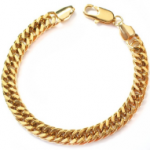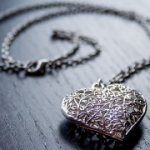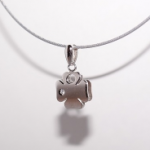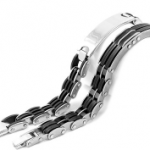
Jewelries are accessories that are used to enhance appearance. In line with this cost and durability come into play. It is therefore important that we go back to the history of jewellery making as well as find out which metals are common and which ones stand out as less common.
History of metals in jewellery Making
Metals are as ancient as the human civilization. In history we come across the metal age. The Mesopotamians, the Greeks, Egyptians and Romans used metals for jewellery making. As new metals continued to be discovered, jewellery making continued to evolve.
Common metals in jewellery making
Of the 86 known metals, only few metals are used in contemporary jewellery. Below are some of those metals that are most common.
 Gold Jewellery has gotten people’s attention given how rare it is and the lustre. In ancient days gold bars were used as a mode of payment given that it was a measure of wealth. As jewellery, gold caught on with the rings to date. It is a fashionable item. Depending on its purity, gold is the most easily worked on. Gold in its pure form however has proved to be too soft for use and therefore has to be mixed with other metals and become an alloy. The highest quality vermeil is 24 karats uses sterling silver. Most gold filled jewellery pieces come as 18 karats. Another gold jewellery is the gold plated jewellery which is electroplated with gold. White gold jewellery is the other version of pure gold. It puts together white metals for instance platinum, silver, nickel and zinc. The downside is the fact that once it begins to wear off it may cause an allergic reaction. The rose gold variety is a combination of copper and gold to create a metal that is golden with reddish hue.
Gold Jewellery has gotten people’s attention given how rare it is and the lustre. In ancient days gold bars were used as a mode of payment given that it was a measure of wealth. As jewellery, gold caught on with the rings to date. It is a fashionable item. Depending on its purity, gold is the most easily worked on. Gold in its pure form however has proved to be too soft for use and therefore has to be mixed with other metals and become an alloy. The highest quality vermeil is 24 karats uses sterling silver. Most gold filled jewellery pieces come as 18 karats. Another gold jewellery is the gold plated jewellery which is electroplated with gold. White gold jewellery is the other version of pure gold. It puts together white metals for instance platinum, silver, nickel and zinc. The downside is the fact that once it begins to wear off it may cause an allergic reaction. The rose gold variety is a combination of copper and gold to create a metal that is golden with reddish hue.
 Silver jewellery. Pure silver, that is fine silver just like gold is too soft and is easily susceptible to damage. It is therefore often mixed with other metals in order for it to be strengthened and consequently to be used in jewellery making. Sterling silver contains 92.5% of pure silver coupled with 7.5% of another metal. Silver Plate falls under the cost effective type of jewellery. However as a con to it is the mere fact that the appearance deteriorates as it wears off quickly. The reason for silver falling into the common category is because it is lustrous, goes so well with casual and formal wear. When it comes to skin tone it flatters any type.
Silver jewellery. Pure silver, that is fine silver just like gold is too soft and is easily susceptible to damage. It is therefore often mixed with other metals in order for it to be strengthened and consequently to be used in jewellery making. Sterling silver contains 92.5% of pure silver coupled with 7.5% of another metal. Silver Plate falls under the cost effective type of jewellery. However as a con to it is the mere fact that the appearance deteriorates as it wears off quickly. The reason for silver falling into the common category is because it is lustrous, goes so well with casual and formal wear. When it comes to skin tone it flatters any type.
 Platinum jewellery. It is deemed more precious than gold given its rare status. It is a white metal that is silvery in appearance. Platinum’s cost is more expensive than gold by just a bit but its popularity over the other metals cannot be downplayed. To fall under the category of platinum the quantity of platinum has to be at least 95%. Less than 95% makes it a platinum alloy.
Platinum jewellery. It is deemed more precious than gold given its rare status. It is a white metal that is silvery in appearance. Platinum’s cost is more expensive than gold by just a bit but its popularity over the other metals cannot be downplayed. To fall under the category of platinum the quantity of platinum has to be at least 95%. Less than 95% makes it a platinum alloy.
 Stainless Steel Jewellery. This resonates with me because the pans and pots in the market all read stainless steel. It is common owing to the fact that it is mostly used in industries. However as a jewellery piece it is extremely fashionable. The necklaces and bracelets all the way to the earrings look great when it comes to appearance and are quite affordable.
Stainless Steel Jewellery. This resonates with me because the pans and pots in the market all read stainless steel. It is common owing to the fact that it is mostly used in industries. However as a jewellery piece it is extremely fashionable. The necklaces and bracelets all the way to the earrings look great when it comes to appearance and are quite affordable.
Less Common Metals in Jewellery Making
These bring out pieces of jewellery that are quite unique. Below are the less common metals in jewellery making. Palladium hails from the platinum family of silver-white metal that is rare. Rhodium is in the platinum family in the rare silver white category. The ‘it’ factor and that which makes it not common is the fact that it is expensive and hard. Titanium comes in a silver white colour. It is three times stronger than steel which makes it hard. The pro to this metal is that it is safe for anyone to use thanks to its hypoallergenic character. Tungsten just like Titanium is hypoallergenic and it is not easily scratched. This makes it a favourite for rings and more so designs with brushed finishing. Copper the oldest known metal is often deemed to have healing qualities…I don’t know how true it is but that is news to me too. Brass is the other less common metal but I understand it falls in this category because of the tarnishing and turning brown. Nickel is known to cause allergic reactions.
